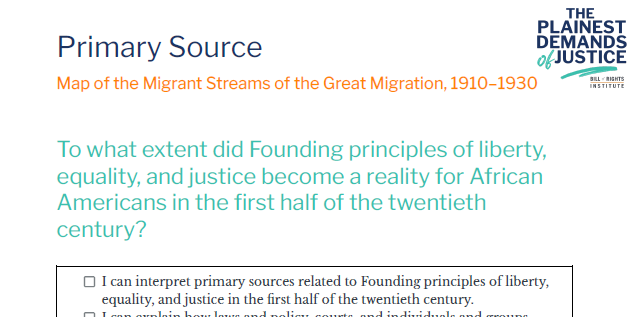Map: Migrant Streams of the Great Migration, 1910-1930
Guiding Question: To what extent did Founding principles of liberty, equality, and justice become a reality for African Americans in the first half of the twentieth century?
- I can interpret primary sources related to Founding principles of liberty, equality, and justice in the first half of the twentieth century.
- I can explain how laws and policy, courts, and individuals and groups contributed to or pushed back against the quest for liberty, equality, and justice for African Americans.
- I can create an argument using evidence from primary sources.
- I can analyze issues in history to help find solutions to present-day challenges.
Building Context
From 1910 to 1930, approximately 1.6 million southern Black Americans moved north, motivated by their experience of segregation, sharecropping, disfranchisement, violence, and racism in the South. Industrial jobs lured many to the North, where they found themselves able to vote and even be elected to office, and vibrant Black neighborhoods with distinct cultures grew in northern cities. Despite the heavy discrimination they still encountered, particularly in employment and housing, Black southerners began to build communities in the North, prompting family and neighbors to join the migration. During World War I, as the United States geared up for war and northern white factory workers joined the armed forces, the number of Black migrants increased dramatically. One scholar writing in 1920 commented, “They left as though they were feeing some curse.”
Map: Migrant Streams of the Great Migration, 1910-1930
“Great Migration” by Bill of Rights Institute/Flickr, CC BY 4.0
This map shows the migrant streams of southern African Americans during the Great Migration from 1910 to 1930.
Comprehension and Analysis Questions
- What factors drove the Great Migration?
- What challenges might Black Americans have faced in northern cities, particularly if their numbers increased dramatically during World War I?

